Arriving just in time for nearly the entire world to find itself stuck at home with lots of free time, Cricut has introduced a cheaper, smaller version of its automated cutting machines that promises to improve your crafty creations. The new Cricut Joy makes a powerful machine relatively affordable, but like a decent home printer, the cost of materials will quickly add up the more you use it.
As someone who finds dabbling in the paper arts a reliable way to destress, I’ve long been interested in Cricut’s machines, which have been available for over a decade. Functionally, the devices fall somewhere between a printer and a plotter that’s able to precisely slice materials (including paper, vinyl, and even fabrics for the larger versions) using a special cutting head that can also be swapped with a pen for making drawings. The Cricut cutters were always too pricey to justify for my occasional hobby, unfortunately, and software limitations made it nearly impossible to import and create my own custom designs from applications such as Adobe Illustrator.

Cricut Joy
WHAT IS IT?
A compact automatic cutting machine designed for crafting.
PRICE
$299.99, plus the cost of additional tools and materials.
LIKE
Clean, precise cuts, easy to use, and with some trial and error you can import your own custom vector art from software like Adobe Illustratror.
DISLIKE
Crafting can quickly get expensive with pre-made projects and the special paper materials you can buy.
A lot has improved with Cricut’s machines over the past decade, however. The Cricut Joy, priced about $100 cheaper than the company’s next largest machine, was created to appeal to more casual crafters like myself, and those with no intentions of trying to turn a profit on their hobbies through sites like Etsy.
The machine’s design is intentionally clean and streamlined, looking even simpler to use than an inkjet printer, which is both a good and bad thing. There are no buttons on the Cricut Joy, not even one for power (you’re supposed to leave it plugged in and in standby mode at all times) because the cutter is entirely operated by other devices connected over Bluetooth. It works well enough, but Bluetooth still comes with connectivity challenges—in this case requiring you to hop into settings to disconnect and reconnect the machine when switching devices—so an additional permanent USB connection for PCs would have been appreciated.
Most of your creativity happens through the Cricut Design Space app which is available for iOS, Android, Windows, and macOS. It provides access to a huge database of pre-made craft projects, ideal for this machine’s target market of dabblers and amateurs, as well as a basic set of tools for creating original projects from scratch. There are free designs to be found in the Cricut’s online store, but most aren’t, and range in price from less than a dollar for simple shapes, to a few bucks for more complex designs.
Unlike a printer that can accept most paper stocks just dropped in its load tray, the Cricut Joy requires materials (in this case no wider than 5.5-inches) to either be attached to rigid cutting mats, or rolls of material, such as adhesive vinyls, that are specially designed to be fed directly into the machine. (Available from Cricut those will set you back about $10 for a single 5.5×48-inch piece.) I recommend paying close attention to the included tutorials you’re given when initially setting up the machine, and additional guides available on YouTube, to understand how specific materials can be properly used in the cutter. It’s not as straightforward as you may think.
Cutting this intricate Mother’s Day card was easy enough, but only after an initial failed attempt taught me how to use a required card cutting mat the hard way. (I hadn’t removed a plastic film protecting an adhesive surface that holds the card flat and secure.) The Cricut Joy is even quieter than a printer when it runs, which surprised me, and watching the arm move back and forth while the material is pulled in and out of the machine is therapeutically hypnotic. I wanted to look away, but I just couldn’t.
But properly loading the Cricut Joy and getting it running is only half the process of making a craft like this Mother’s Day card. To remove it safely from the adhesive card mat without tearing the intricate design required about 15 minutes of carefully removing smaller pieces with a pointed weeding tool, and then prying up the rest of the card with a tiny spatula. With practice, my skills at this task will undoubtedly improve, but I can’t imagine someone being able to complete this project without the optional $25 Cricut Joy Starter Tool Set. So after just one project, which also used two pieces of Cricut-specific card stock, the tool set, and a $US6 ($9) Cricut Joy Card Mat, it became clear that the machine’s $299.99 price tag was just the tip of the iceberg.
As someone familiar with more powerful design tools like Adobe Illustrator, I was curious how capable the Cricut Joy, and more specifically the Cricut Design Space software, were for making more complex custom creations. The software comes with a basic set of tools for creating text using various fonts that can be paired with pre-defined shapes or imported images, but I quickly discovered that if you’re going to try to make your own projects, Design Space is easier to use on a PC or laptop with a mouse or trackpad. I don’t recommend trying to use it on a smaller smartphone screen.
My goal was to create a custom lid label for a kitchen garbage can used to collect biodegradable materials for composting. I started with a pre-made recycling logo I found online, which was distributed as an Illustrator vector file that the Cricut software simply wouldn’t touch. After some trial and error, and many, many file exports, I eventually found I could reliably get vector files into the Cricut Design Space software after exporting them as SVGs from Illustrator.
The Cricut software then let me rescale the artwork to fit the Joy’s 5.5-inch size limits and even re-arrange the three individual pieces to be closer together to minimise wasting the adhesive vinyl material I used. Re-using materials like vinyl strips can be tricky, but as long as you save your project files, you’ll know exactly where you can position new elements that can be cut from the remaining sections of pre-cut materials.
I was pleasantly surprised with the results from the Cricut Joy. The cutter did a much better job on the adhesive vinyl than thicker card stock, with lines that were cleaner and smoother, making the individual shapes easy to peel away. There’s no chance I’d ever be able to get the same results by hand using a hobby knife. Getting the custom design into the Cricut Design Space software was by no means a struggle, but I did rely on Adobe Illustrator which is a pricey piece of software that not everyone has access to. And as with the Mother’s Day card I created, the hardest part came after the Cricut had completed its slicing.
Overall I was happy with the functionality that Cricut has carried over from its larger machines to the new Joy. It’s targeted at crafters, but with some finessing, it could potentially also be a useful tool for professional graphic designers who need to create the occasional mockup of a product or a packaging design—although with some trial and error that can potentially get expensive in the long run. There’s always the option of cutting your own paper stock to fit the Cricut Joy’s limited dimensions (the cutting mats should work fine with almost any paper or vinyl stock they can adhere to) but if you’re interested in the machine as a way to make crafting easier, you’ll need to just accept that streamlining your hobby is going to require a bigger crafting budget.
README
-
At $299.99 it’s the cheapest and easiest to use Cricut cutting machine to date, but you’ll want to budget extra for materials, tools, and pre-made projects from the Cricut online store. Like printing at home, the costs will add up quickly.
-
Familiarising yourself with how the cutter works is a crucial first step. Materials need to be fed into the machine using special cutting mats, and many projects feature multiple steps, swapping between a cutting head and markers.
-
Setting up the cutter and sending it a design to slice is easy, but you’ll still need some basic craft skills to carefully remove projects, particularly intricate designs, from the adhesive cutting mats.
-
No buttons on the Cricut Joy means there’s no way to turn it off. It’s always in standby mode unless you physically unplug it.
-
Connectivity is exclusively Bluetooth, ensuring it can connect to everything from mobile devices to computers, but you’ll occasionally have connectivity issues as Bluetooth is far from perfect.
-
You can create your own custom designs with the Cricut Design Space software, and even import patterns as vector files from apps like Adobe Illustrator, but it will require some trial and error experimentation.
